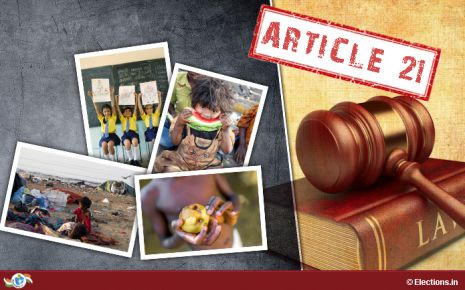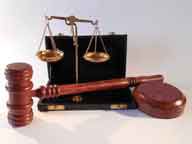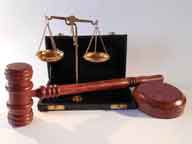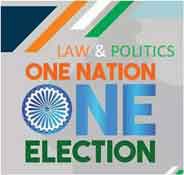Application Of Basic Structure Theory In Different Cases
The date of 24th April is extensively highlighted in the history of basic
structure doctrine of Constitution and political arena of Indian democracy. On
this same date, in 1973 a special bench comprising 13 judges of Supreme Court of
India gave the landmark judgment in the history of Indian Judiciary by a
majority of 7-6 that article 368 of part XX of the constitution "does not enable
Parliament to abrogate or take away, fundamental rights or to completely change
the fundamental features of the Constitution so as to destroy its identity.
Within these limits Parliament can amend every article."
(Kesvananda Bharti vs. The State of Kerla). It gave the most supreme law to the people of India, i.e. the basic structure doctrine however it overruled a decision of a Special Judge bench of 11 judges, by a majority of 6-5, that "power to amend Part III of the Constitution so as to take away or abridge the fundamental rights" ( I.C. Golak Nath & Ors. vs. The State of Punjab & Ors).
This not only protects the fundamental rights of the citizens but also the dignity and integrity of the people of India. In this paper we will know about the different cases that leads to the basic structure doctrine, from pre-Kesvananda position to the basic structure concept reaffirmed in the Indira Gandhi Election case.
The Indian Constitution, what is the first thing that comes to our mind when hear of this word? It is a book of rules to enable coordination among members of society. It's the highest law of land, delineating the core political principles, structures and procedures. The main objective is to establish Constitutional Supremacy, rather than Parliamentary Supremacy. The Preamble of Indian Constitution upholds the sovereign, socialist, secular, democratic republic justice, liberty, equality, fraternity, and Republic Nation.
Now let's understand what basic structure doctrine is, It is one of the fundamental judicial principles connected with the Indian Constitution. It was actually in the Kesavananda Bharati V. Sate of Kerla case, it was the 13 judge bench case in which the verdict ruled by Supreme Court was 7-6 verdict that parliament can amend any part of the constitution but not the basic structure or any other essential feature of the constitution. Indian Constitution can be amended by the parliament at any point of time wherever needed for the society. In the Article 368 "Power of Parliament to amend the Constitution and procedure" amend wherever necessity, it also lays down the procedure to amend in detail.
So now what is basic structure doctrine, it actually the accountability check over the parliament or judicial innovation to ensure that parliament don't misuse the power of amendment. The basic idea that is developed is that the basic structure doctrine should not be altered or changed. Any amendment cannot change these principles and this is what the doctrine of basic structure upholds. In this research paper we would try to understand the evolution of the doctrine basic structure and what are the features of the constitution that were the part of basic structure in hon'ble courts.
Doctrine basic structure is basically judge made doctrine to put limitation on amending power of the parliament so that it cannot be amended in its constituent power, so the question arises is that to which extent the constitution can be amended?
Edmund Burke has said about the constitution is that the "a Constitution is an ever growing thing and is perpetually continuous as it embodies the spirit of the nation. It is enriched at present by the past influence and it makes the future richer than the present." Article 368[1] of Part XX deals with it.
A petition was submitted to the Supreme Court of India opposing Article(s) 31A and 31B on the grounds that they violate the spirit of Article13(2) by limiting or eliminating rights granted under Part III of the Constitution and should, therefore, be declared invalid. The Hon'ble Supreme Court of India ruled in the case of Shankari Prasad Singh Deo v. Union of India that the power to amend the Constitution, including the Fundamental Rights, is granted under Article 368 and that the term "Law" as used in Article 13(2) does not include an amendment to the Constitution. There is a difference between the legislative power, often known as the legislative power of the Parliament, and the amending or constitutive powers of the Parliament.
Following this, the Constitution underwent a number of revisions, and in the Sajjan Singh v. State of Rajasthan case, the extent of the amendments was once again contested. In Sajjan Singh, a five-judge panel considered the constitutionality of the 17th Constitutional Amendment, which had expanded the 9th Schedule by about 44 acts. The concurring opinion by Hidyatullah and Mudholkar JJ raised questions for the first time about the unrestricted capacity of Parliament to change the Constitution and restrict individuals' fundamental rights, even though all of the justices agreed with Shankari Prasad's ruling.
The Court did not, however, declare the First, Fourth, or Seventeenth Amendments illegal since the decision had prospective application. This meant that no more amendments to the Constitution could be made that would violate fundamental rights. Nonetheless, the Court found that the instances of Shankari Prasad and Sajjan Singh were unconstitutional in that Article 13(2) does not include a constitutional change made in accordance with Article 368.
The modification resulted in the following alterations:
A 13-judge court gave the landmark decision, which overturned the Golak Nath case with a vote of 7:6. It was decided that while Parliament has broad authority to change the Constitution and can do so at any time, it is not boundless enough to change the Constitution's fundamental structure or elements.
The 24th Amendment, according to the US Supreme Court, simply explicitly declares what was already present tacitly. Article 368 has always included the authority and process to modify the Constitution; hence it does not increase the powers of Parliament. The judges supplied an example list of what might be the basic structure but did not specify what the basic structure is.
Whereas Jaganmohan Redd, J., believed that it was the Preamble that laid down the basic features of the Constitution, which are:
Evolution of Basic Structure Doctrine
The court case Indra Nehru Gandhi v. Raj Narain served as an affirmation and foundation for the idea. In this instance, the appellant had appealed the Allahabad High Court's ruling declaring the Prime Ministerial election of the appellant to be unconstitutional. The 39th Amendment, which stated that no court has jurisdiction over the Prime Minister's election challenges, was passed into law and placed into effect while the Supreme Court's appeal was still underway.
In its ruling, the Hon. Supreme Court cited the Kesavananda Bharati case as support for its assertion that democracy is a fundamental component of the Constitution. The bench included the Rule of Law and the authority of Judicial Review to the list of the fundamental components.
The basic doctrine framework was then established in the case of Minerva Mills Ltd. v. Union of India, in which the Supreme Court clarified the concept and established that the power of modification under Article 368 is restricted and that it cannot be exercised in an unrestricted manner. A restricted ability to change the Constitution was undoubtedly a component of its fundamental design.
Nevertheless, the basic framework also includes the harmony and balance between fundamental rights and guiding principles; anything that upsets this equilibrium is ipso facto a violation of the doctrine.
In the case of L. Chandra Kumar v. Union of India, it was once again established that the basic structure doctrine applies to the judicial review power granted by Articles 32 of the Supreme Court and 226 of the High Court, and that this power cannot be diminished by transferring it to administrative tribunals.
Conclusion
There is currently no debate on the doctrine's existence; the only issue that continually surfaces is its content. While some of its contents are currently being debated, several have been repeatedly upheld by the Courts. The basic structure theory provides the delicate balancing act between flexibility and rigidity that ought to be incorporated in every Constitution's amendment powers.
(Kesvananda Bharti vs. The State of Kerla). It gave the most supreme law to the people of India, i.e. the basic structure doctrine however it overruled a decision of a Special Judge bench of 11 judges, by a majority of 6-5, that "power to amend Part III of the Constitution so as to take away or abridge the fundamental rights" ( I.C. Golak Nath & Ors. vs. The State of Punjab & Ors).
This not only protects the fundamental rights of the citizens but also the dignity and integrity of the people of India. In this paper we will know about the different cases that leads to the basic structure doctrine, from pre-Kesvananda position to the basic structure concept reaffirmed in the Indira Gandhi Election case.
The Indian Constitution, what is the first thing that comes to our mind when hear of this word? It is a book of rules to enable coordination among members of society. It's the highest law of land, delineating the core political principles, structures and procedures. The main objective is to establish Constitutional Supremacy, rather than Parliamentary Supremacy. The Preamble of Indian Constitution upholds the sovereign, socialist, secular, democratic republic justice, liberty, equality, fraternity, and Republic Nation.
Now let's understand what basic structure doctrine is, It is one of the fundamental judicial principles connected with the Indian Constitution. It was actually in the Kesavananda Bharati V. Sate of Kerla case, it was the 13 judge bench case in which the verdict ruled by Supreme Court was 7-6 verdict that parliament can amend any part of the constitution but not the basic structure or any other essential feature of the constitution. Indian Constitution can be amended by the parliament at any point of time wherever needed for the society. In the Article 368 "Power of Parliament to amend the Constitution and procedure" amend wherever necessity, it also lays down the procedure to amend in detail.
So now what is basic structure doctrine, it actually the accountability check over the parliament or judicial innovation to ensure that parliament don't misuse the power of amendment. The basic idea that is developed is that the basic structure doctrine should not be altered or changed. Any amendment cannot change these principles and this is what the doctrine of basic structure upholds. In this research paper we would try to understand the evolution of the doctrine basic structure and what are the features of the constitution that were the part of basic structure in hon'ble courts.
Doctrine basic structure is basically judge made doctrine to put limitation on amending power of the parliament so that it cannot be amended in its constituent power, so the question arises is that to which extent the constitution can be amended?
Edmund Burke has said about the constitution is that the "a Constitution is an ever growing thing and is perpetually continuous as it embodies the spirit of the nation. It is enriched at present by the past influence and it makes the future richer than the present." Article 368[1] of Part XX deals with it.
Pre - Golak Nath Era
In 1951, the Indian Constitution underwent a change that added the contentious Articles 31A and 31B. The 9th Schedule was established by Article 31B, and it declared that no law issued under it may be contested on the grounds that it violated fundamental rights in accordance with Article 13(2) of the Constitution. According to Article 13(2), the Parliament may not enact legislation that reduces the rights granted under Part III; legislation that does so will be null and void.A petition was submitted to the Supreme Court of India opposing Article(s) 31A and 31B on the grounds that they violate the spirit of Article13(2) by limiting or eliminating rights granted under Part III of the Constitution and should, therefore, be declared invalid. The Hon'ble Supreme Court of India ruled in the case of Shankari Prasad Singh Deo v. Union of India that the power to amend the Constitution, including the Fundamental Rights, is granted under Article 368 and that the term "Law" as used in Article 13(2) does not include an amendment to the Constitution. There is a difference between the legislative power, often known as the legislative power of the Parliament, and the amending or constitutive powers of the Parliament.
Following this, the Constitution underwent a number of revisions, and in the Sajjan Singh v. State of Rajasthan case, the extent of the amendments was once again contested. In Sajjan Singh, a five-judge panel considered the constitutionality of the 17th Constitutional Amendment, which had expanded the 9th Schedule by about 44 acts. The concurring opinion by Hidyatullah and Mudholkar JJ raised questions for the first time about the unrestricted capacity of Parliament to change the Constitution and restrict individuals' fundamental rights, even though all of the justices agreed with Shankari Prasad's ruling.
Golak Nath v. the State of Punjab
Three writ petitions were combined in this instance. The Punjab Security of Land Tenures Act, 1953 was not included in the Ninth Schedule, as was opposed by Golak Nath's children in the first one. The Mysore Land Reforms Act's inclusion in the Ninth Schedule was contested in the other two cases.- Article 368 does not diminish the power of Parliament to alter the Constitution; instead, it derives from Article 245 when read in conjunction with Item 97 of List I of the Constitution. It was made very clear that Article 368 solely covered the Amendment Procedure and nothing else.
- The Court also made it clear that a modification to the Constitution is included in the definition of "law" under Article 13(2). So any modification against the Basic Rights was void.
- The claim that the ability to change the Constitution is a sovereign power, independent of legislative authority and hence not subject to judicial review, was refuted.
The Court did not, however, declare the First, Fourth, or Seventeenth Amendments illegal since the decision had prospective application. This meant that no more amendments to the Constitution could be made that would violate fundamental rights. Nonetheless, the Court found that the instances of Shankari Prasad and Sajjan Singh were unconstitutional in that Article 13(2) does not include a constitutional change made in accordance with Article 368.
Constitution 24th Amendment
The Golak Nath case stripped the Parliament of its authority to modify the Constitution at will, therefore the 24th Constitutional Amendment was proposed to return things to how they had been. The Amendment Act increased Parliament's authority while also restoring the previous state of affairs.The modification resulted in the following alterations:
- Nothing in this Article shall apply to any amendment of this Constitution made according to Article 368, according to a new clause 4 that was inserted into Article 13.
- The marginal heading of Article 368 was modified to 'Power of Parliament to modify the Constitution and Process, hence' from 'Procedure for amendment of the Constitution.'
- In addition, a new sub clause (1) was added to Article 368 that stated that, "regardless of anything contained in this Constitution, Parliament may, in the exercise of its Constituent Power, amend by way of addition, variation, or repeal any provision of this Constitution in accordance with the procedure laid out in this Article."
- By modifying the phrase "it shall be brought to the President who shall give his assent to the Bill and thereafter" to "it shall be presented to the President for his assent and upon such assent being given to the Bill," the President was required to assent to any bill amending the Constitution.
- A reassuring clause (3) was also added to Article 368, which again stated that 'nothing in Article 13 shall apply to any alteration made under this Article.'
Kesvananda Bharati v. the State of Kerala
The Kerala Land Reforms Act of 1963 was originally the subject of this lawsuit, which was brought to trial. But, the Constitution's 29th Amendment moved it to the Ninth Schedule. The legitimacy of the 24th and 25th Amendments could potentially be contested by the petitioner in addition to the 29th Amendment.A 13-judge court gave the landmark decision, which overturned the Golak Nath case with a vote of 7:6. It was decided that while Parliament has broad authority to change the Constitution and can do so at any time, it is not boundless enough to change the Constitution's fundamental structure or elements.
The 24th Amendment, according to the US Supreme Court, simply explicitly declares what was already present tacitly. Article 368 has always included the authority and process to modify the Constitution; hence it does not increase the powers of Parliament. The judges supplied an example list of what might be the basic structure but did not specify what the basic structure is.
According to Sikri, C.J., the fundamental structure consists of the following components:
- The supremacy of the Constitution
- Republican and Democratic forms of Government
- Secular character of the Constitution
- Separation of Powers between the legislature, the Executive, and the Judiciary
- Federal Character of the Constitution
Shelat and Grover, JJ., added the following to the above list:
- The mandate to build a welfare state contained in the Directive Principles of State Policy
- Maintenance of the unity and integrity of India
- The sovereignty of the country
- The sovereignty of India
- The democratic character of the polity
- The unity of the country
- Essential features of individual freedom
- The mandate to build a welfare state
Whereas Jaganmohan Redd, J., believed that it was the Preamble that laid down the basic features of the Constitution, which are:
- A sovereign democratic republic
- The provision of social, economic, and political justice
- Liberty of thought, expression, belief, faith, and worship
- Equality of status and opportunity
Evolution of Basic Structure Doctrine
The court case Indra Nehru Gandhi v. Raj Narain served as an affirmation and foundation for the idea. In this instance, the appellant had appealed the Allahabad High Court's ruling declaring the Prime Ministerial election of the appellant to be unconstitutional. The 39th Amendment, which stated that no court has jurisdiction over the Prime Minister's election challenges, was passed into law and placed into effect while the Supreme Court's appeal was still underway.
In its ruling, the Hon. Supreme Court cited the Kesavananda Bharati case as support for its assertion that democracy is a fundamental component of the Constitution. The bench included the Rule of Law and the authority of Judicial Review to the list of the fundamental components.
The basic doctrine framework was then established in the case of Minerva Mills Ltd. v. Union of India, in which the Supreme Court clarified the concept and established that the power of modification under Article 368 is restricted and that it cannot be exercised in an unrestricted manner. A restricted ability to change the Constitution was undoubtedly a component of its fundamental design.
Nevertheless, the basic framework also includes the harmony and balance between fundamental rights and guiding principles; anything that upsets this equilibrium is ipso facto a violation of the doctrine.
In the case of L. Chandra Kumar v. Union of India, it was once again established that the basic structure doctrine applies to the judicial review power granted by Articles 32 of the Supreme Court and 226 of the High Court, and that this power cannot be diminished by transferring it to administrative tribunals.
Conclusion
There is currently no debate on the doctrine's existence; the only issue that continually surfaces is its content. While some of its contents are currently being debated, several have been repeatedly upheld by the Courts. The basic structure theory provides the delicate balancing act between flexibility and rigidity that ought to be incorporated in every Constitution's amendment powers.
Law Article in India
Legal Question & Answers
Lawyers in India - Search By City
LawArticles
How To File For Mutual Divorce In Delhi

How To File For Mutual Divorce In Delhi Mutual Consent Divorce is the Simplest Way to Obtain a D...
Increased Age For Girls Marriage

It is hoped that the Prohibition of Child Marriage (Amendment) Bill, 2021, which intends to inc...
Facade of Social Media

One may very easily get absorbed in the lives of others as one scrolls through a Facebook news ...
Section 482 CrPc - Quashing Of FIR: Guid...

The Inherent power under Section 482 in The Code Of Criminal Procedure, 1973 (37th Chapter of t...
The Uniform Civil Code (UCC) in India: A...

The Uniform Civil Code (UCC) is a concept that proposes the unification of personal laws across...
Role Of Artificial Intelligence In Legal...

Artificial intelligence (AI) is revolutionizing various sectors of the economy, and the legal i...








Please Drop Your Comments